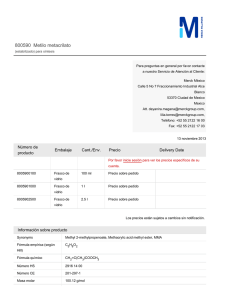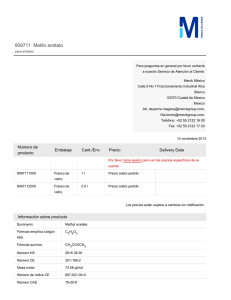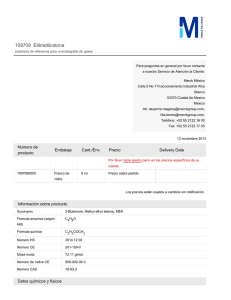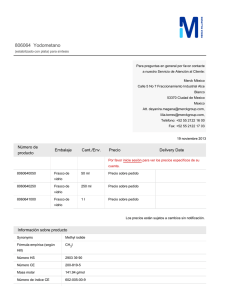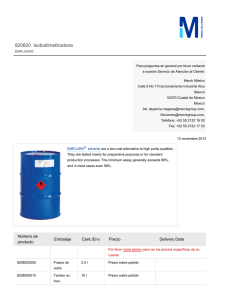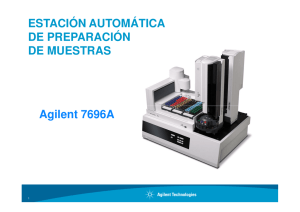Síntesis de alcoholes grasos insaturados a partir de metilésteres
Anuncio
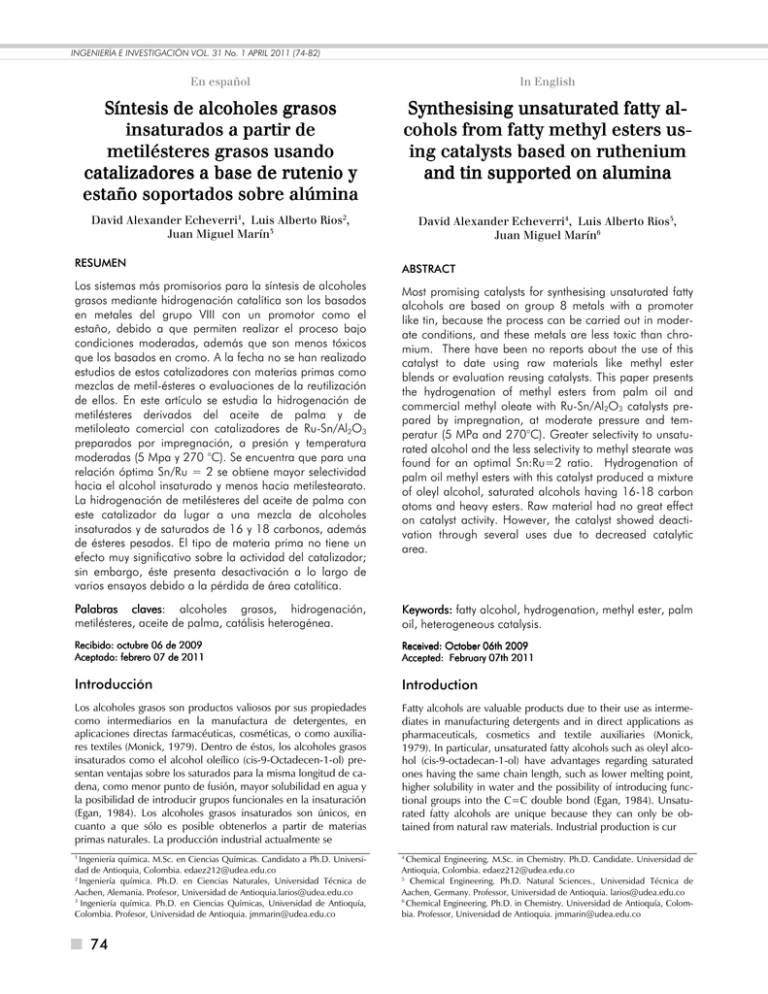
INGENIERÍA E INVESTIGACIÓN VOL. 31 No. 1 APRIL 2011 (74-82) En español In English Síntesis de alcoholes grasos insaturados a partir de metilésteres grasos usando catalizadores a base de rutenio y estaño soportados sobre alúmina Synthesising unsaturated fatty alcohols from fatty methyl esters using catalysts based on ruthenium and tin supported on alumina David Alexander Echeverri1, Luis Alberto Rios2, Juan Miguel Marín3 David Alexander Echeverri4, Luis Alberto Rios5, Juan Miguel Marín6 RESUMEN ABSTRACT Los sistemas más promisorios para la síntesis de alcoholes grasos mediante hidrogenación catalítica son los basados en metales del grupo VIII con un promotor como el estaño, debido a que permiten realizar el proceso bajo condiciones moderadas, además que son menos tóxicos que los basados en cromo. A la fecha no se han realizado estudios de estos catalizadores con materias primas como mezclas de metil-ésteres o evaluaciones de la reutilización de ellos. En este artículo se estudia la hidrogenación de metilésteres derivados del aceite de palma y de metiloleato comercial con catalizadores de Ru-Sn/Al2O3 preparados por impregnación, a presión y temperatura moderadas (5 Mpa y 270 °C). Se encuentra que para una relación óptima Sn/Ru = 2 se obtiene mayor selectividad hacia el alcohol insaturado y menos hacia metilestearato. La hidrogenación de metilésteres del aceite de palma con este catalizador da lugar a una mezcla de alcoholes insaturados y de saturados de 16 y 18 carbonos, además de ésteres pesados. El tipo de materia prima no tiene un efecto muy significativo sobre la actividad del catalizador; sin embargo, éste presenta desactivación a lo largo de varios ensayos debido a la pérdida de área catalítica. Most promising catalysts for synthesising unsaturated fatty alcohols are based on group 8 metals with a promoter like tin, because the process can be carried out in moderate conditions, and these metals are less toxic than chromium. There have been no reports about the use of this catalyst to date using raw materials like methyl ester blends or evaluation reusing catalysts. This paper presents the hydrogenation of methyl esters from palm oil and commercial methyl oleate with Ru-Sn/Al2O3 catalysts prepared by impregnation, at moderate pressure and temperatur (5 MPa and 270°C). Greater selectivity to unsaturated alcohol and the less selectivity to methyl stearate was found for an optimal Sn:Ru=2 ratio. Hydrogenation of palm oil methyl esters with this catalyst produced a mixture of oleyl alcohol, saturated alcohols having 16-18 carbon atoms and heavy esters. Raw material had no great effect on catalyst activity. However, the catalyst showed deactivation through several uses due to decreased catalytic area. Palabras claves: claves alcoholes grasos, hidrogenación, metilésteres, aceite de palma, catálisis heterogénea. Keywords: fatty alcohol, hydrogenation, methyl ester, palm oil, heterogeneous catalysis. Recibido: octubre 06 de 2009 Aceptado: febrero 07 de 2011 Received: October 06th 2009 Accepted: February 07th 2011 Introducción Introduction Los alcoholes grasos son productos valiosos por sus propiedades como intermediarios en la manufactura de detergentes, en aplicaciones directas farmacéuticas, cosméticas, o como auxiliares textiles (Monick, 1979). Dentro de éstos, los alcoholes grasos insaturados como el alcohol oleílico (cis-9-Octadecen-1-ol) presentan ventajas sobre los saturados para la misma longitud de cadena, como menor punto de fusión, mayor solubilidad en agua y la posibilidad de introducir grupos funcionales en la insaturación (Egan, 1984). Los alcoholes grasos insaturados son únicos, en cuanto a que sólo es posible obtenerlos a partir de materias primas naturales. La producción industrial actualmente se Fatty alcohols are valuable products due to their use as intermediates in manufacturing detergents and in direct applications as pharmaceuticals, cosmetics and textile auxiliaries (Monick, 1979). In particular, unsaturated fatty alcohols such as oleyl alcohol (cis-9-octadecan-1-ol) have advantages regarding saturated ones having the same chain length, such as lower melting point, higher solubility in water and the possibility of introducing functional groups into the C=C double bond (Egan, 1984). Unsaturated fatty alcohols are unique because they can only be obtained from natural raw materials. Industrial production is cur 1 4 Ingeniería química. M.Sc. en Ciencias Químicas. Candidato a Ph.D. Universidad de Antioquia, Colombia. edaez212@udea.edu.co 2 Ingeniería química. Ph.D. en Ciencias Naturales, Universidad Técnica de Aachen, Alemania. Profesor, Universidad de Antioquia.larios@udea.edu.co 3 Ingeniería química. Ph.D. en Ciencias Químicas, Universidad de Antioquía, Colombia. Profesor, Universidad de Antioquia. jmmarin@udea.edu.co 74 Chemical Engineering. M.Sc. in Chemistry. Ph.D. Candidate. Universidad de Antioquia, Colombia. edaez212@udea.edu.co 5 Chemical Engineering. Ph.D. Natural Sciences., Universidad Técnica de Aachen, Germany. Professor, Universidad de Antioquia. larios@udea.edu.co 6 Chemical Engineering. Ph.D. in Chemistry. Universidad de Antioquía, Colombia. Professor, Universidad de Antioquia. jmmarin@udea.edu.co ECHEVERRY, RIOS, MARÍN En español In English basa en la hidrogenación a alta presión (260-300 °C y 25-30 MPa) de metilésteres y ácidos grasos, obtenidos respectivamente mediante transesterificación e hidrólisis del aceite (Kreutzer, 1984; Voeste, 1984). Estos procesos utilizan catalizadores sólidos del tipo cromita de zinc que favorecen la reacción de hidrogenación selectiva del grupo carbonilo en vez de la del doble enlace carbono-carbono (Adkins y Sauer, 1937). Las desventajas de estos procesos son las condiciones severas de reacción y la lixiviación de cromo hexavalente, conocido por su alta toxicidad en los ecosistemas. rently based on high-pressure hydrogenation (260-300°C and 25 -30 MPa) of methyl esters and fatty acids, obtained respectively by transesterification and hydrolysis of oil (Kreutzer, 1984; Voest, 1984). These processes use zinc chromite type catalysts promoting selective hydrogenation of the carbonyl group instead of the C=C double bond (Adkins and Sauer, 1937). The disadvantages of these processes lie in the severe reaction conditions and the leaching of hexavalent chromium known for its high toxicity in natural ecosystems. En la actualidad existen regulaciones medioambientales fuertes que presionan la búsqueda de nuevos procesos más eficientes y menos contaminantes. Desde hace aproximadamente 20 años se vienen realizando investigaciones con catalizadores de metales del grupo VIII como rutenio, con un segundo metal como el estaño, que actúa como promotor; estos sistemas han permitido realizar la reacción de hidrogenación de metilésteres y ácidos grasos a condiciones menos drásticas (8 MPa y 270 °C), además estos metales presentan menor toxicidad que el cromo (Narasimhan, 1990; Cheah, 1992; Cheah, 1994; Tahara, 1997; Pouilloux, 1998; Pouilloux, 2001; Echeverri, 2009; Echeverri, 2010; Sánchez, 2011). Según lo reportado en estos artículos existe una relación molar óptima entre el promotor y el metal activo que permite obtener la máxima selectividad al alcohol insaturado. At present, strong environmental regulations force the search for new more efficient and less polluting processes. Research during the last 20 years has been focused on Group 8 metal catalysts such as ruthenium with a second metal, such as tin, acting as promoter. These systems have resulted in methyl ester and fatty acid hydrogenation in less drastic conditions (8 MPa and 270°C). Besides, these metals are less toxic than chromium (Narasimhan, 1990; Cheah, 1992; Cheah, 1994; Tahara, 1997, Pouilloux, 1998; Pouilloux, 2001; Echeverri, 2009; Echeverri, 2010; Sanchez, 2011). As reported in these papers, there is an optimum molar ratio between promoter and active metal allowing maximum unsaturated alcohol selectivity. Todas las anteriores investigaciones se han llevado a cabo con materias primas puras como el metiloleato. Sin embargo, en la síntesis comercial de alcoholes grasos insaturados se emplean mezclas de metilésteres o ácidos grasos derivados de aceites como girasol, palma, palmiste y coco. Además, otro aspecto de gran importancia que no se ha estudiado con estos catalizadores es la de su reutilización. Nuestro país actualmente es el quinto productor de aceite de palma; además, hay un porcentaje importante que se exporta como aceite crudo, y el resto se utiliza en aplicaciones comestibles (Jaimes, 2004; Ríos, 2006). Por lo tanto, hay un gran potencial de utilizar este aceite como materia prima para aplicaciones oleoquímicas de alto valor agregado. All prior investigations have been carried out with pure raw materials such as methyl oleate. However, fatty acid methyl ester mixtures derived from oils such as sunflower, palm, palm kernel and coconut are used in the commercial synthesis of unsaturated fatty alcohol. Catalyst reuse is another very important aspect which has not been studied. Colombia is currently the world's fifth producer of palm oil. A substantial percentage of oil is expor -ted as crude oil and the rest is used in food applications (Jaimes, 2004; Ríos, 2006). Palm oil thus has great potential as feedstock for oleochemical applications having high added value. En este estudio se analiza, en primer lugar, la hidrogenación de metiloleato comercial a 5 MPa y 270 °C con catalizadores heterogéneos de rutenio y estaño monometálicos y bimetálicos soportados por impregnación sobre γ-alúmina. Asimismo, se estudia el efecto de la relación molar estaño-rutenio sobre el desempeño de los catalizadores. Teniendo como base los anteriores resultados se estudia el catalizador que presentó mayor selectividad en la hidrogenación de metilésteres derivados de la fracción oleína del aceite de palma durante diferentes tiempos. Finalmente, se analizan los resultados de conversión y selectividad del mismo catalizador durante varias reutilizaciones con metilésteres del aceite de palma. This study evaluated the hydrogenation of commercial methyl oleate at 5 MPa and 270°C with monometallic and bimetallic ruthenium heterogeneous catalysts and tin supported by impregnation on g-alumina. The effect of the tin-ruthenium molar ratio on catalyst performance was also analysed. Based on these results, the catalyst showing the highest selectivity was studied in the hydrogenation of methyl esters derived from the olein fraction of palm oil at different times. Conversion and selectivity results for the catalyst are analysed for several types of reuse. Desarrollo experimental Experimental Materiales. Materials. El metiloleato (80% p/p), los precursores metálicos (RuCl3.nH2O, SnCl2.2H2O), así como la gamma alúmina, se obtuvieron de Sigma-Aldrich. La fracción oleína del aceite de palma se obtuvo de la extractora Bajirá (Antioquia). Methyl oleate (80% w/w), metal precursors (RuCl3.nH2O, SnCl2.2H2O,) and gamma alumina were obtained from SigmaAldrich. The palm oil olein fraction was obtained from Extractora Bajirá (Antioquia). INGENIERÍA E INVESTIGACIÓN VOL. 31 No. 1, APRIL 2011 (74-82) 75 SÍNTESIS DE ALCOHOLES GRASOS INSATURADOS A PARTIR DE METILÉSTERES … / SYNTHESISING UNSATURATED FATTY ALCOHOLS FROM FATTY METHYL … En español In English Síntesis de metilésteres (FAME) del aceite de palma. Oil palm fatty acid methyl ester (FAME) synthesis. La fracción oleína del aceite de palma (RBD) se sometió a transesterificación con metanol, utilizando KOH en relación de 0,7% en peso respecto al aceite, a temperatura de 65 °C durante 2 horas en un sistema de reflujo; condiciones previamente optimizadas con el fin de obtener los mayores rendimientos. La relación molar aceite/alcohol es de 1 a 6. Posteriormente se separó la fase glicerina de la fase éster en un embudo de separación; esta última se lavó con agua caliente hasta pH neutro. El metanol remanente se separó por medio de roto-evaporación en un baño de agua a 90 °C. The RBD palm oil olein fraction was obtained by transesterification with methanol using 0.7% KOH by weight with respect to oil. The temperature was 65°C, maintained for 2 hours in a reflux system. These conditions had been previously optimized to obtain higher FAME yields. The oil/alcohol molar ratio was 1 to 6. Glycerol was separated from ester phase in a separating funnel. The latter was washed with hot water until neutral pH was obtained. The remaining methanol was removed by rotoevaporation in a water bath at 90°C. Preparación de catalizadores. Catalyst preparation. Los catalizadores monometálicos y bimetálicos se obtuvieron mediante el método de impregnación. En ellos se mantuvo fijo el porcentaje de rutenio en el soporte, que fue de 2%. Las relaciones molares estaño/rutenio que se manejaron fueron de 0,5, 1 y 2. Los precursores metálicos se disolvieron en agua y la γ -Al2O3, previamente desgasificada en nitrógeno, se impregnó con esta solución de acuerdo al método descrito por Narasimhan et al. (Narasimhan, 1990). Los sólidos obtenidos se secaron bajo presión reducida. Antes de su uso los catalizadores se calcinaron en aire a 450 °C y luego se redujeron con hidrógeno a 450 °C y se pasivaron en aire a temperatura ambiente. Los catalizadores monometálicos de rutenio y estaño se designan en este trabajo como Ru/Al2O3 y Sn/Al2O3 respectivamente. Los catalizadores bimetálicos se designan como Ru-Sn/Al2O3–X, donde X es la relación molar de Sn/Ru. Monometallic and bimetallic catalysts were synthesized by impregnation. There was 2% ruthenium on the support. Tin/ ruthenium molar ratios were 0.5, 1 and 2. The g-Al2O3 was previously degassed in nitrogen and the metal precursors were dissolved in water. The solid was then impregnated with this solution according to the method described by Narasimhan et al., (Narasimhan, 1990). The solids were dried under reduced pressure. Before use, the catalysts were calcined in air at 450°C and then reduced with hydrogen at 450°C and passivated in air at room temperature. Monometallic ruthenium and tin catalysts have been designated in this work as Sn/Al2O3 and Ru/Al2O3, respectively. Bimetallic catalysts have been designated as Ru-Sn/ Al2O3-X, where X was the Sn:Ru molar ratio. Caracterización de catalizadores. Characterising catalysts. El área superficial, así como el tamaño y volumen de poro, se analizaron mediante un equipo Gemini V de Micromeritics empleando nitrógeno líquido como adsorbato. Las muestras se desgasificaron a 200 °C en una atmósfera de nitrógeno durante 1 hora antes de los ensayos. Surface area, pore size and pore volume were analysed using a Micromeritics Gemini V, using liquid nitrogen as adsorbate. The samples were degassed at 200°C in a nitrogen atmosphere for 1 hour before testing. Reacción de hidrogenación. Hydrogenation reaction. Ésta se llevó a cabo en un reactor batch (27 mL) equipado con agitación magnética El reactor se cargó con el metiléster y el catalizador; luego se purgó con hidrógeno cuatro veces a 2 MPa para eliminar el aire. La temperatura se incrementó a 270 °C a presión constante (2 MPa) y posteriormente se aumentó hasta 5 MPa, dejándola estable durante la reacción. El avance de las reacciones de hidrogenación se determinó tomando muestras a lo largo del tiempo. This was carried out in a batch reactor (27 mL) equipped with magnetic stirring The reactor was charged with methyl ester and the catalyst and then purged with hydrogen at 2MPa four times to remove air. The temperature was increased to 270°C at constant pressure (2 MPa) and subsequently increased to 5 MPa, keeping it stable during the reaction. Hydrogenation reaction progress was determined by taking samples at fixed times. Análisis de productos. Product analysis. Las materias primas se sometieron a caracterización fisicoquímica que incluye el contenido de agua, el índice de saponificación, el número de yodo y el índice de acidez. La composición tanto de las materias primas como de los productos de reacción se analizaron por cromatografía gaseosa empleando una columna capilar de 50 m x 0,25 mm RTX-5 y un detector TCD. El gas de arrastre fue el hidrógeno. Las materias primas se derivatizaron a metilésteres antes del análisis. El análisis se realizó por medio de curva de calibración. Complementario al anterior, se realizó la identificación de componentes por cromatografía de gases aco -plada a masas (detector de cuadrupolo) con la misma columna antes descrita. También se hizo la caracterización en un equipo Raw materials were physicochemically characterised including water content, saponification value, iodine value and acid value. Raw material and reaction product compositions were analysed by gas chromatography using a 50 m x 0.25 mm RTX-5 capillary column and a TCD detector. The carrier gas was hydrogen. The raw materials were derivatised to methyl esters before analysis. The analysis was performed by calibration curve. Complementary to the previous analysis, components were identified by gas chromatography with mass detector (quadrupole) using the column described above. Characterisation was also performed by Fourier transform infrared (FTIR) spectrometry with a Shimadzu IR Prestige-21, using KBr cells. 76 INGENIERÍA E INVESTIGACIÓN VOL. 31 No. 1, APRIL 2011 (74-82) ECHEVERRY, RIOS, MARÍN En español In English de infrarrojo con transformada de Fourier, modelo IRprestige-21 de Shimadzu, empleando celdas de KBr. Reutilización de catalizadores. Catalyst reuse. El catalizador, una vez terminada la reacción de hidrogenación, se separó de la mezcla mediante microfiltración con un un filtro de membrana Advantec MFS de 0,45 µm. Posteriormente el catalizador se lavó con hexano con el fin de eliminar la mayor parte del aceite. Finalmente el sólido se seca en una estufa a 60 °C durante una hora. El catalizador se utiliza hasta cuatro veces. The catalysts were recovered after the hydrogenation reaction. The reaction mixture was removed by microfiltration with a 0.45 mm Advantec MFS membrane filter. Catalysts were then washed with hexane to remove most of the oil. The solid was dried in an oven at 60°C for one hour. The catalyst was used 4 times. Resultados y discusión Results and discussion 1. Propiedades de materias primas 1. Raw materials’ properties En las tablas 1 y 2 se muestran los resultados de los análisis de composición y de índices fisicoquímicos de las materias primas. Es de observar que la principal diferencia entre la materia prima de origen comercial y la derivada del aceite de palma radica en el menor contenido de ácidos grasos insaturados en esta última (oleico y linoleico) a cambio de un mayor porcentaje de saturados (palmítico, esteárico), lo que se ve reflejado en su menor índice de yodo. Tables 1 and 2 give the results of analysing the raw materials’ composition and physicochemical parameters. It should be noted that the main difference between the raw material from commercial sources and that derived from palm oil lay in the lowest unsaturated fatty acid content in the latter (oleic and linoleic). Palm oil had a higher percentage of saturated fatty acids (palmitic, stearic), reflected in its lower iodine content. 2. Characterising catalysts 2. Caracterización de catalizadores According to solid material classification, microporous ones are defined as those having smaller than 2 nm pore size, mesoporous materials have 2 to 50 nm pore size and macroporous ones have greater than 50 nm pore size. The solid catalysts obtained (Table 3) could be described as mesoporous. Regarding commercial alumina, catalysts impregnated on this support had less surface area and less pore size and pore volume, possibly due to some pores being covered by the metal support. Catalyst reuse (4 times) had a dramatic effect on its structural properties, especially on surface area which showed more than 50% reduction. Such decrease may have been due to agitator grinding effect and reaction product deposition in the pores of the catalyst. Según la clasificación de materiales sólidos, los microporosos se definen como los que tienen tamaño de poro menor de 2 nm, los mesoporosos entre 2 y 50 nm y los macroporosos mayor a 50 nm. Es así como los catalizadores sólidos obtenidos (tabla 3) se pueden catalogar como mesoporosos. Con respecto a la alúmina comercial, los catalizadores impregnados sobre este soporte presentan disminución en el área superficial y en el tamaño y volumen de poro, posiblemente debido al bloqueo de alguna fracción de los poros por parte de los metales soportados. La reutilización del catalizador durante 4 veces tuvo un drástico efecto sobre sus propiedades estructurales, pero sobre todo en el área superficial, que presentó una reducción de más del 50%. Esta disminución se puede deber tanto al efecto de molienda del agitador como a la deposición de productos de reacción en los poros del catalizador. Table 1. Raw materials’ physicochemical parameters Tabla 1. Propiedades fisicoquímicas de materias primas Parámetro Fisicoquímico Contenido de agua Índice de acidez Índice de saponificación Índice de yodo Norma ASTM D-4377 ASTM D-1980 Materia Prima FAME FAME Comercial Oleina - RBD 0.2 0.2 0.2 0.3 ASTM D-5558 195.7 194.5 ASTM D-5554 85.4 57.5 Physico-chemical parameters Metiloleato comercial Metilésteres de oleína RBD C12:0 0,762 0,299 C14:0 2,796 0,956 Porcentaje en metilésteres C16:0 C16:1 C18:0 5,464 3,336 0,747 37,561 0,232 5,304 Water % Acid Value ASTM D-4377 ASTM D-1980 Saponification value Iodine value ASTM D-5558 ASTM D-5554 Raw material Commercial RBD palm FAMES olein FAMES 0.2 0.2 0.2 0.3 195.7 85.4 194.5 57.5 Table 2. Raw materials’ composition Tabla 2. Composición de materias primas Materia prima Standard method C18:1 71,011 47,047 3. Análisis de productos de reacción Según los espectros de infrarrojo de la materia prima y el pro- C18:2 10,700 7,764 Raw material Commercial methyl oleate RBD palm olein FAME C12:0 0.762 0.299 C14:0 2.796 0.956 Methyl esters % C16:0 C16:1 C18:0 5.464 3.336 0.747 37.561 0.232 5.304 C18:1 71.011 47.047 C18:2 10.700 7.764 3. Analysing reaction products Changes occurring in functional groups participating in the reac- INGENIERÍA E INVESTIGACIÓN VOL. 31 No. 1, APRIL 2011 (74-82) 77 SÍNTESIS DE ALCOHOLES GRASOS INSATURADOS A PARTIR DE METILÉSTERES … / SYNTHESISING UNSATURATED FATTY ALCOHOLS FROM FATTY METHYL … En español In English ducto de hidrogenación, es posible identificar los cambios que se dan en los grupos funcionales participantes de la reacción (figura 1). Los grupos susceptibles de reaccionar son el grupo carbonilo y la insaturación, cuyas bandas de infarrojo se presentan principalmente a 1.742 y 1.642 cm-1 respectivamente. En el producto de reacción se evidencia la disminución en la intensidad del pico correspondiente al grupo carbonilo debido a su reducción a alcohol (3.450 cm-1). Es de anotar que se sigue presentando la banda a 1.642, que puede deberse tanto a la insaturación de la materia prima sin reaccionar como del alcohol oleílico formado. tion were identified according to raw material and hydrogenation product infrared spectra (Figure 1). The groups prone to reacting were the carbonyl group and the C=C double bond whose infrared bands mainly appeared at 1,742 and 1,642 cm-1 respectively. Decreased reaction product peak intensity corresponding to the carbonyl group was observed due to its reduction to alcohol (3,450 cm-1). It should be noted that the band at 1,642 remained, which may have been due to the non-saturation of the unreacted raw material and/or of oleyl alcohol formed. Tabla 3. Área superficial, volumen y tamaño de poro de diferentes catalizadores sintetizados Table 3. Several catalysts’ surface area, pore volume and size Catalizador γ-Alúmina comercial Ru-Sn/Al2O3-0,5 Ru-Sn/Al2O3-1,0 Ru-Sn/Al2O3-2,0 Ru/Al2O3 Sn/Al2O3 Ru-Sn/Al2O3-2,0 (r) c Área Superficial (m2/g) 133.67 115.78 115.02 114.97 127.54 124.01 50.02 Volumen de poroa (cm3/g) 0.2561 0.2245 0.2351 0.2122 0.245 0.223 0.1224 Tamaño de poro b (nm) 5.793 5.651 5.687 5.587 5.652 5.591 3.820 Catalizador Surface area (m2/g) Pore volumea (cm3/g) Pore size b (nm) Commercial γ-Alumina 133.67 0.2561 5.793 Ru-Sn/Al2O3-0,5 Ru-Sn/Al2O3-1,0 Ru-Sn/Al2O3-2,0 Ru/Al2O3 Sn/Al2O3 Ru-Sn/Al2O3-2,0 (r) c 115.78 115.02 114.97 127.54 124.01 50.02 0.2245 0.2351 0.2122 0.245 0.223 0.1224 5.651 5.687 5.587 5.652 5.591 3.820 a a Volumen de poro obtenido cerca a la saturación. b Tamaño promedio de poro obtenido de la correlación BJH en la adsorción. c Catalizador utilizado cuatro veces Pore volume obtained near saturation Average pore size obtained from BJH correlation in adsorption c Catalyst used 4 times b Los principales productos de reacción identificados fueron el alcohol oleílico, el alcohol estearílico, el alcohol palmitílico y el oleil oleato (figura 2). El alcohol oleílico se forma de la hidrogenación selectiva del metiloleato sobre el grupo carbonilo; el alcohol estearílico se forma por la hidrogenación tanto del grupo carbonilo como de la insaturación del metiloleato o del metilestearato. A su vez, el alcohol palmitílico se forma a partir del metilpalmitato. El oleiloleato es considerado como un éster pesado derivado de la transesterificación del metiloleato con el alcohol oleílico formado en una etapa anterior (figura 3) (Pouilloux, 2001). The main reaction products were identified as being oleyl alcohol, stearyl alcohol, palmitoyl alcohol and oleyl oleate (Figure 2). Oleyl alcohol was formed in the selective hydrogenation of methyl oleate in the carbonyl group; stearyl alcohol was formed by the hydrogenation of both the carbonyl group and the nonsaturation of methyl oleate or methyl stearate. In turn, palmitoyl alcohol was formed from methyl palmitate. Oleyl oleate was considered a heavy ester derived from the transesterification of methyl oleate with oleyl alcohol formed in an earlier stage (Figure 3) (Pouilloux, 2001). Figura 1. Espectro de infrarrojo de: (a) metiloleato comercial. (b) mezcla de reacción. Figure 1. Infrared spectra: (a) commercial methyl oleate (b) reaction mixture Al analizar las conversiones de metiloleato obtenidas en función del tiempo (figura 2a) se observa que los catalizadores de rutenio monometálicos fueron los más activos, con conversiones casi Methyl oleate conversion as a function of time is analysed in Figure 2a. Monometallic ruthenium catalysts were the most active, having almost total methyl ester conversion. Monometallic tin catalyst had the lowest methyl oleate conversion. Adding tin 78 INGENIERÍA E INVESTIGACIÓN VOL. 31 No. 1, APRIL 2011 (74-82) ECHEVERRY, RIOS, MARÍN En español In English totales del metiléster. En cuanto a los catalizadores de estaño monometálicos, presentaron la más baja conversión de metiloleato. La adición de estaño disminuye la actividad de los catalizadores monometálicos de rutenio drásticamente, ya que aún para la más baja relación del metal la conversión cae a valores máximos de 20%. El estaño puede inhibir la actividad del catalizador al depositarse sobre los sitios activos o al favorecer la formación de ésteres pesados que impiden el acceso de hidrógeno (Pouilloux, 2001). dramatically decreased monometallic ruthenium catalyst activity since, even for the lowest Sn/Ru ratio, conversion dropped to a maximum 20%. Tin can inhibit ruthenium activity when deposited on active sites or promote heavy ester formation blocking hydrogen access (Pouilloux, 2001). Figura 2. Hidrogenación de metiloleato comercial. a) Conversión en función Figure 2. Commercial methyl oleate hydrogenation. (a) Conversion as a func- del tiempo de metiloleato de catalizadores: (♦) Ru/Al2O3; (•) Sn/Al2O3; () Ru-Sn/Al2O3-0,5; (▼) Ru-Sn/Al2O3-1,0 () Ru-Sn/Al2O3-2,0. b) Distribución de productos obtenidos con los diferentes catalizadores sintetizados para un tiempo de reacción de 8 horas. tion of methyl oleate time with: (♦) Ru/Al2O3; (•) Sn/Al2O3; () Ru-Sn/Al2O3 -0,5; (▼) Ru-Sn/Al2O3-1,0 () Ru-Sn/Al2O3-2,0 (b) Distribution of products obtained with different catalysts for an 8-hours reaction time. O H3C (CH2)7 (CH2)7 C Metiloleato H3C (CH2)7 (CH2)7 C Alcohol oleílico O O H3C (CH2)7 (CH2)7CH2OH OCH3 OCH2 (CH2)7 (CH2)7CH3 Oleíl Oleato H3C (CH2)7 (CH2)7 C Methyl Oleate O H3C (CH2)7 (CH2)7CH2OH H3C (CH2)7 (CH2)7 C OCH3 Oleyl alcohol OCH2 (CH2)7 (CH2)7CH3 Oleyl Oleate Figura 3. Reacción de transesterificación de metilésteres y alcohol oleílico Figure 3.Transesterification reaction of methyl oleate and oleyl alcohol Respecto a la distribución de productos obtenida (figura 2b) se observó el gran efecto que tiene el estaño como promotor sobre las propiedades del rutenio. Es así como el rutenio monometálico es altamente activo en la reacción de hidrogenación pero no es selectivo hacia la producción de alcohol insaturado, siendo la principal reacción la hidrogenación del enlace olefínico, como se ha establecido por otros autores (Cheah, 1994). Dependiendo de la relación Sn/Ru se presentaron como principales productos de reacción: el metilestearato, que es el éster saturado producto de la hidrogenación del enlace olefínico del metiloleato, o los ésteres pesados (figura 3). En general, al aumentar la relación Sn/ Ru se disminuye la formación de metilestearato y se aumenta la de ésteres pesados y la de alcohol oleílico. Esto indica que la adición de estaño tiene como efecto disminuir la selectividad de los catalizadores hacia el enlace olefínico y al mismo tiempo The great effect of tin as a promoter of ruthenium properties was shown regarding the distribution of the products so obtained (Fig. 2b). Thus, monometallic ruthenium was highly active in the hydrogenation reaction but was not selective regarding unsaturated alcohol production and the main reaction was olefinic bond hydrogenation, as stated by other authors (Cheah, 1994). The main reaction product obtained depended on Sn:Ru ratio: methyl stearate (the saturated ester product of methyl oleate or heavy ester olefinic bond hydrogenation) (Figure 3). Increasing the Sn:Ru ratio decreased methyl stearate formation and increased heavy ester and oleyl alcohol formation. This indicated that adding tin had the effect of reducing catalyst selectivity to the olefinic bond and, at the same time, increased interaction with the carbonyl group. However, tin promoted the formation of heavy esters, as reported in other studies with these catalysts INGENIERÍA E INVESTIGACIÓN VOL. 31 No. 1, APRIL 2011 (74-82) 79 SÍNTESIS DE ALCOHOLES GRASOS INSATURADOS A PARTIR DE METILÉSTERES … / SYNTHESISING UNSATURATED FATTY ALCOHOLS FROM FATTY METHYL … En español In English aumentar la interacción con el grupo carbonilo; no obstante, favorece la formación de ésteres pesados, como se he reportado en otros estudios con estos catalizadores (Cheah, 1992; Cheah,1994; Tahara, 1997). (Cheah, 1992; Cheah, 1994; Tahara, 1997). El catalizador Ru-Sn/Al2O3-2,0 con el cual se obtuvo mejor selectividad en la hidrogenación de metiloleato se evaluó en la hidrogenación de metilésteres de fase oleína de aceite de palma RBD durante varias horas (figura 4a). Se obtuvieron en general conversiones un poco menores utilizando este sustrato en comparación con el metiloleato comercial. Esto puedo deberse a que el catalizador pudo sufrir desactivación por impurezas presentes en la materia prima tal como compuestos que contienen cloro, nitrógeno, fósforo, además de los ácidos grasos libres, tal como lo han anotado algunos estudios donde se ha demostrado su influencia negativa en el desempeño de catalizadores como cromitas de zinc y de cobre (Voeste, 1984; Poels, 1999). Estas impurezas se presentan principalmente en aceites de coco, palma y palmiste. The Ru-Sn/Al2O3-2,0 catalyst, which presented the highest selectivity in methyl oleate hydrogenation, was evaluated in RBD palm olein FAME hydrogenation for several hours (Figure 4a). Conversions were slightly lower using this substrate compared to commercial methyl oleate. This could have been attributed to catalyst deactivation by impurities in raw materials such as compounds containing chlorine, nitrogen, phosphorus, in addition to free fatty acids. Several studies have shown its negative influence on the performance of catalysts such as zinc chromite and copper (Voest, 1984; Poels, 1999). These impurities are mainly present in coconut oil and palm kernel oil. Figura 4. Hidrogenación de FAME de oleína de aceite de palma RBD con el catalizador Ru-Sn/Al2O3-2,0. a) Conversión en función del tiempo de metiloleato. b) Distribución de productos obtenidos para diferentes tiempos de reacción. Figure 4. Hydrogenation of RBD palm olein FAMEs with the Ru-Sn/Al2O3-2,0 catalyst. (a) Conversion as a function of methyl oleate time (b) Distribution of products obtained for different reaction times. En cuanto a la distribución de productos obtenida con el aceite de palma (figura 4b) se puede establecer que los principales productos obtenidos fueron ésteres pesados, alcohol oleílico, metilestearato, ácidos grasos de 18 carbonos, así como los alcoholes saturados estearílico y palmitílico. Es de destacar que se obtuvo una cantidad considerablemente mayor de alcohol saturado comparado a lo obtenido con el FAME comercial. Esto se debe al mayor contenido de metiléster saturado (metilestearato), el cual se transforma al alcohol correspondiente. Asimismo, la presencia del metilpalmitato en la materia prima da lugar al alcohol palmitílico. También se observa que al transcurrir la reacción luego de 4 horas los ésteres pesados disminuyen al According to the distribution of products obtained from palm oil (Fig. 4b), it could be established that the main products were heavy esters, oleyl alcohol, methyl stearate, 18-carbon fatty acids, stearyl alcohol and palmitoyl alcohol. It is noteworthy that a considerably greater amount of saturated alcohol was obtained compared to commercial methyl oleate. This was due to higher saturated methyl ester content (methyl stearate) which was transformed into the corresponding alcohol. Likewise, the presence of methyl palmitate in the raw material produced palmityl alcohol. It was also noted that heavy esters decreased after 4 hours reaction while fatty alcohol formation increased due to the hydrogenation of the former. The product obtained using palm oil was 80 INGENIERÍA E INVESTIGACIÓN VOL. 31 No. 1, APRIL 2011 (74-82) ECHEVERRY, RIOS, MARÍN En español In English tiempo que aumenta la formación de alcoholes grasos debido a la hidrogenación de los primeros. El producto obtenido utilizando aceite de palma tuvo consistencia semisólida a temperatura ambiente, a diferencia del obtenido a partir del FAME comercial que era líquido, sin embargo las dos materias primas son líquidas a 25 °C. Este cambio se pudo deber a la reacción indeseable de saturación de enlaces olefínicos en el proceso de hidrogenación. semisolid at room temperature, unlike this one obtained from commercial methyl oleate which was liquid, though both raw materials are liquid at 25°C. This change could have been due to olefinic bond saturation during hydrogenation. En cuanto a la estabilidad del catalizador, mediante varias reutilizaciones (figura 5) se observó que la conversión disminuyó en aproximadamente 35% para la última reutilización respecto al primero, lo cual puede ser considerable si se tiene en cuenta que se utilizó sólo cuatro veces. Esta pérdida de actividad puede ser causada por la severa disminución en el área superficial evidenciada en el análisis BET. La selectividad hacia el alcohol oleílico también se vio afectada, posiblemente debido la lixiviación de metales en la mezcla de reacción evidenciada cualitativamente en el proceso de microfiltración. Es de anotar que la disposición del catalizador empleado fue en la forma de slurry, es decir, que se encuentra suspendido en el líquido y por tanto sufre el proceso de atrición por la agitación mecánica. Otro diseño de reactor que podría mejorar la estabilidad del catalizador sería en lecho fijo, sólo que en este caso habría que garantizar una buena transferencia de masa con la fase gaseosa. Regarding catalyst stability through several reuses (Fig. 5), it was observed that conversion decreased by about 35% for the last reuse compared to the first one which could be considerable taking into account that it was used only 4 times. This loss of activity may have been caused by severe reduction in surface area, as shown by BET analysis. Selectivity to oleyl alcohol was also affected, possibly due to leaching of metals during the reaction mixture shown qualitatively during micro-filtration. It should be noted that the catalyst used was in the form of slurry. Therefore the catalyst was suspended in the liquid, undergoing attrition by mechanical agitation. Another type of reactor design that could improve catalyst stability would be fixed-bed; however, it would be necessary to ensure good mass transfer with the gas phase. Figura 5 . Selectividad hacia alcohol oleílico y conversión de metiloleato en función del número de usos del catalizador Ru-Sn/Al2O3-2,0 en la hidrogenación de metilésteres de oleína de aceite de palma RBD. Figure 5. Oleyl alcohol selectivity and conversion of methyl oleate regarding the number of Ru-Sn/Al2O3-2,0 catalyst uses, in RBD palm olein methyl ester hydrogenation. Conclusiones Conclusions El catalizador bimetálico Ru-Sn/Al2O3-2,0 permite realizar la hidrogenación selectiva del grupo carbonilo de metilésteres en vez de la del enlace olefínico a presión moderada. Sin embargo, la principal reacción competitiva es la de formación de ésteres pesados. Por lo tanto, el tiempo de reacción se debe aumentar en más de ocho horas para hidrogenar estos ésteres pesados y formar los respectivos alcoholes grasos. La hidrogenación de los metilésteres del aceite de palma a los respectivos alcoholes es factible con el catalizador mencionado, sólo que se forman también alcoholes saturados, además la actividad del catalizador se disminuye poco si se compara con la obtenida utilizando como sustrato el metiloleato comercial. El catalizador permite ser reutilizado hasta cuatro veces; no obstante, se debe tener en cuenta el diseño de reactor más adecuado para evitar pérdida de área superficial y daños estructurales del catalizador. A futuro se puede pensar en trabajos donde se evalúen disposiciones diferentes del reactor (como en lecho fijo) y el efecto que esto pueda tener The bimetallic catalyst Ru-Sn/Al2O3-2,0 enabled selective methyl ester carbonyl group hydrogenation instead of that of the olefinic bond at moderate pressure. However, the main competitive reaction was heavy ester formation. Therefore, reaction time should be increased by more than 8 hours to hydrogenate these heavy esters and produce the respective fatty alcohols. The hydrogenation of palm oil methyl esters to respective alcohols was feasible with the catalyst mentioned, but saturated alcohols were also formed. Besides, catalyst activity became slightly decreased compared to that obtained using commercial methyl oleate as substrate. The catalyst can be reused up to 4 times; however, the most appropriate type of reactor must be evaluated to avoid loss of catalyst surface area and structural damage. Future studies will involve using different reactor design (for example fixed bed reactor) and assessing the effect of such configuration on catalyst selectivity and conversion. INGENIERÍA E INVESTIGACIÓN VOL. 31 No. 1, APRIL 2011 (74-82) 81 SÍNTESIS DE ALCOHOLES GRASOS INSATURADOS A PARTIR DE METILÉSTERES … / SYNTHESISING UNSATURATED FATTY ALCOHOLS FROM FATTY METHYL … En español In English sobre la selectividad y la conversión del catalizador. Agradecimientos Acknowledgements Los autores expresan su agradecimiento a la Universidad de Antioquia por la financiación de la investigación por medio de la Estrategia de Sostenibilidad de Grupos. The authors would like to thank the Universidad de Antioquia for providing financial support through its Group Sustainability Strategy. Referencias / References Adkins, H., Sauer, J., The selective hydrogenation of unsaturated esters to unsaturated alcohols., Journal of the American Chemical Society, Vol. 59, No. 1, Ene.,1937, pp.1-3. Narasimhan, C.S., Deshpande, V.M., Ramnarayan, K., Studies on ruthenium-tin boride catalysts I. Characterizaction., Journal of Catalysis, Vol.121 No.1, Ene., 1990, pp.165-173. Cheah, K.Y., Tang, T.S., Mizukami, F., Niwa, S., Toba, M., Choo, Y.M., Selective hydrogenation of oleic acid to 9octadecen-1-ol: catalysts preparation and optimum reaction conditions., Journal of the American Oil Chemists’ Society, Vol. 69, No. 5, May.,1992, pp.410-416. Narasimhan, C.S., Deshpande, V.M., Ramnarayan, K., Studies on ruthenium-tin boride catalysts II. Hydrogenation of fatty acid esters to fatty alcohols., Journal of Catalysis, Vol. 121, No.1, Ene., 1990, pp.174-182. Cheah, K.Y., Tang, T.S., Mizukami, F, Niwa, S, Toba, M., Hydrogenation of 9-octadecenoic acid by Ru-Sn-Al2O3 catalysts: effects of catalyst preparation method., Journal of the American Oil Chemists’ Society, Vol. 71 No. 5, May.,1994, pp. 501-506. Echeverri, D.A., Marín, J. M., Restrepo, G. M., Rios, L.A., Characterization and carbonylic hydrogenation of methyl oleate over Ru-Sn/Al2O3: Effects of metal precursor and chlorine removal., Applied Catalysis A: General, Vol 366, No 2, Sept., 2009, pp. 342-347. Echeverri, D.A., Marín, J. M., Rios, L.A., Hidrogenación de Metil Oleato con Catalizadores de Ru-Sn/Al2O3: Método Sol-gel vs. Impregnación., Información Tecnológica, Vol 21, No 3, May., 2010, pp. 77-86. Egan, R., Earl, G.W., Ackerman, J., Properties and uses of some unsaturated fatty alcohols and their derivatives., Journal of the American Oil Chemists’ Society, Vol. 61, No.2, Feb., 1984; pp. 324-329. Jaimes, D., Romero, C.A., Narváez, P.C., Principales tecnologías para la elaboración de oleoquímicos a partir de los aceites de palma y palmiste., Palmas, Vol. 25, No.1, Ene., 2004; pp. 47-64. Kreutzer, U., Manufacture of Fatty Alcohols Based on Natural Fats and Oils., Journal of the American Oil Chemists’ Society, Vol. 61, No.2, Feb.,1984, pp.343-348. Monick, J.A., Fatty alcohols, Journal of the American Oil Chemists’ Society., Vol. 56, No.2, Feb., 1979, pp. 853-860 A. 82 INGENIERÍA E INVESTIGACIÓN VOL. 31 No. 1, APRIL 2011 (74-82) Poels, E.K., Sulfur deactivation of fatty esters hydrogenolysis catalysts., Journal of Catalysis, Vol. 186, No.1, Ago., 1999, pp.169-180. Pouilloux, Y., Autin, F., Guimon, C., Barrault, J., Hydrogenation of fatty acids over ruthenium-tin catalysts; characterization and identification of active centers., Journal of Catalysis, Vol. 176, No.1, May.,1998, pp. 215-224. Pouilloux, Y., Barrault, J., De Oliveira, K., Selective hydrogenation of methyl oleate into unsaturated alcohols in the presence of cobalt-tin supported over zinc oxide catalysts., Journal of Catalysis, Vol. 204, No.1, Dic., 2001, pp. 230-237. Rios, L.A, Franco, A, Echeverri, D.A., Producción de alcoholes grasos a partir de aceites de palma y de palmiste utilizando procesos de hidrogenación catalítica. Una revisión Bibliográfica., Palmas, Vol. 27, No.1, Ene., 2006, pp. 65-76. Sánchez, M.A., Mazzieri, V.A., Sad, M.R., Grau, R., Pieck, C. L., Influence of preparation method and boron addition on the metal function properties of RuSn catalysts for selective carbonyl hydrogenation., Journal of Chemical Technology & Biotechnology, Vol. 86, No 3, Oct., 2011, pp 447–453. Tahara, K., Nagahara, E., Itoi, Y., Nishiyama, S., Tsuruya, S., Masai, M., Liquid-phase hydrogenation of carboxylic acid on supported Ru-Sn-alumina catalysts., Applied Catalysis A: General, Vol. 154, No.1, Jun., 1997, pp. 75-86. Voeste, T., Buchold, H., Production of fatty alcohols from fatty acids., Journal of the American Oil Chemists’ Society, Vol. 61, No.2, Feb.,1984, pp. 350-352.
